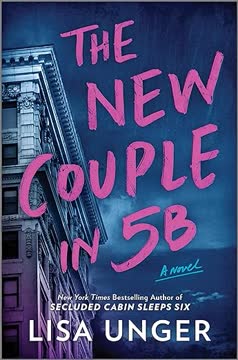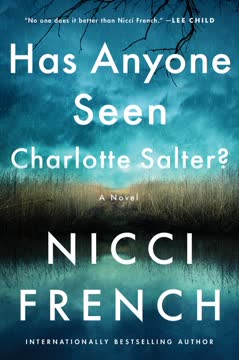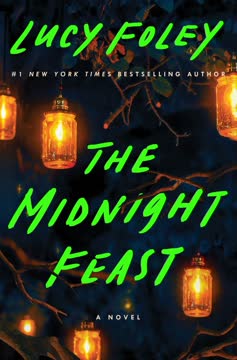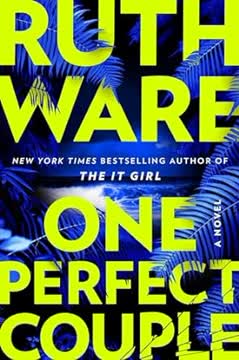Plot Summary
The Sleep Specialist's Secret
Dr. Benedict Prince is a renowned psychologist specializing in sleep disorders, particularly those involving crimes committed during sleep. His career is marked by a notorious case involving Anna O, a woman accused of murder while in a deep sleep. This case haunts Prince, challenging his understanding of the human psyche and the thin line between sleep and consciousness. His work delves into the darkest corners of the mind, leaving him to question the true nature of guilt and innocence.
A Mysterious Midnight Call
One night, Dr. Prince receives a call from Dr. Virginia Bloom, a colleague at The Abbey Sleep Clinic, about a delicate case requiring his expertise. Despite being on leave, Prince is drawn into the mystery surrounding Anna O, a woman in a deep sleep for years. The case is both professional and personal for Prince, as it forces him to confront the potential darkness within the human mind and the implications of Anna's condition.
The Enigma of Anna O
At The Abbey Sleep Clinic, Prince is tasked with awakening Anna O, who has been asleep for four years following a violent incident. The case is fraught with legal and ethical challenges, as the government seeks to bring Anna to trial for murder. Prince must navigate the complexities of her condition, exploring the psychological and neurological factors that have kept her in this state, uncovering layers of trauma and secrets.
A Family's Hidden Past
Prince's investigation leads him to Emily Ogilvy, Anna's mother, who reveals a history of sleepwalking and family dysfunction. Emily recounts incidents from Anna's childhood that hint at a pattern of sleep-related disturbances. As Prince pieces together the Ogilvy family's past, he begins to understand the psychological underpinnings of Anna's condition, challenging his perceptions of guilt and innocence.
The Awakening Begins
Prince's unconventional methods begin to show results as Anna exhibits signs of consciousness. Through sensory stimulation and psychological engagement, he attempts to bridge the gap between her mind and body. The process is delicate, requiring patience and precision. As Anna starts to respond, Prince is filled with hope and responsibility, aware that her awakening could hold the key to solving the mystery of her past actions.
The Shadow of the Past
The investigation takes a darker turn as Prince discovers a link between Anna's case and the infamous Sally Turner, known as the "Monster of Stockwell." Turner's acquittal due to sleepwalking casts a long shadow over Anna's situation. Prince uncovers a hidden report by Dr. Bloom suggesting a deeper conspiracy involving psychological experiments, raising questions about culpability and the potential for history to repeat itself.
The Truth Behind the Sleep
As Prince delves deeper, he uncovers a web of deceit and manipulation extending beyond Anna's personal history. The truth about the night of the murders and the forces keeping Anna asleep are revealed. Prince must confront the ethical implications of his findings and decide whether to protect Anna or expose the truth. The resolution challenges his beliefs about justice, redemption, and the power of the human mind to heal.
Anna's Awakening and Mother's Guilt
Anna finally opens her eyes after four years, leaving her mother, Emily, overwhelmed. Emily reflects on her past, once a powerful political figure, now a shadow of her former self. As Anna's consciousness returns, Emily is haunted by the fear of what Anna might remember about the night of the murders. The reunion is bittersweet, overshadowed by the looming threat of a trial and media frenzy.
The Trial Looms Over Anna
Dr. Prince faces the daunting task of preparing Anna for the impending trial. The legal system is eager to prosecute Anna for the murders, but Prince is determined to protect her until she is fully conscious. The political pressures are immense, with the Justice Minister pushing for a swift trial. Prince and Emily are caught in uncertainty, knowing Anna's fate hangs in the balance.
Prince's Dilemma and Anna's Fate
As Anna regains her faculties, Prince grapples with the ethical implications of his role. He is torn between his professional duty to awaken Anna and his personal desire to shield her from harsh realities. The possibility of Anna suffering from post-traumatic amnesia complicates matters, leaving Prince to question whether she will ever fully remember the events of that fateful night.
The Granja's Dark Secrets Unveiled
Prince and Harriet visit the Granja, the site of the murders, to uncover the truth. As they retrace Anna's steps, they confront the chilling reality of what happened. The Granja holds many secrets, revealing a complex web of deceit and manipulation, suggesting Anna may not have acted alone. The visit raises more questions than answers, leaving Prince to ponder Anna's true involvement.
Anna's Story: A New Beginning
With the trial behind her, Anna is given a chance to start anew. The revelations about her past and the manipulation she endured have left her scarred but determined to reclaim her life. As she steps into the world once more, Anna is resolved to tell her story on her own terms, seeking redemption and understanding. Her journey is one of healing and self-discovery, as she strives to make peace with her past.
Characters
Dr. Benedict Prince
Dr. Benedict Prince is a psychologist specializing in sleep disorders, particularly those involving criminal acts committed during sleep. His work is both his passion and his burden, as he grapples with the ethical and psychological complexities of his cases. Prince is haunted by the case of Anna O, which has become a defining moment in his career. His dedication to uncovering the truth is driven by a deep sense of responsibility and a desire to understand the darkest corners of the human mind.
Anna Ogilvy (Anna O)
Anna Ogilvy, known as Anna O, is a woman who has been in a state of deep sleep for four years following a violent incident. Her case is shrouded in mystery, as she is accused of murder but unable to defend herself due to her condition. Anna's past is marked by trauma and family dysfunction, and her sleep is both a refuge and a prison. As she begins to awaken, the truth of her actions and the events leading up to her sleep are gradually revealed.
Dr. Virginia Bloom
Dr. Virginia Bloom is a colleague of Prince at The Abbey Sleep Clinic and a key figure in the investigation into Anna O's case. Her past work at Broadmoor, a high-security psychiatric hospital, holds secrets that are crucial to understanding Anna's condition. Bloom's untimely death leaves Prince with unanswered questions and a sense of urgency to uncover the truth she was trying to reveal.
Emily Ogilvy
Emily Ogilvy is Anna's mother, a woman whose life has been upended by her daughter's condition. Once a prominent political figure, Emily has retreated into a life of quiet reflection and religious devotion. Her revelations about Anna's childhood and the family's history of sleep disturbances provide crucial insights into the psychological factors at play in Anna's case. Emily's struggle to reconcile her past decisions with the present reality of her daughter's situation adds depth to the narrative.
Richard Ogilvy
Richard Ogilvy is Anna's father, a man whose relationship with his daughter is marked by distance and misunderstanding. As a successful financier, Richard is accustomed to control and authority, but Anna's condition forces him to confront his own limitations. His interactions with Prince reveal a man grappling with guilt and a desire to protect his family, even as he struggles to understand the forces that have shaped Anna's life.
Harriet Roberts
Harriet Roberts is a nurse at The Abbey Sleep Clinic who becomes an important ally to Prince in the treatment of Anna O. Her dedication to her patients and her intuitive understanding of Anna's needs make her an invaluable part of the team. Harriet's insights into Anna's condition and her ability to connect with the patient on a personal level provide a counterbalance to the clinical approach of the other medical professionals.
Sally Turner
Sally Turner, known as the "Monster of Stockwell," is a figure from the past whose case bears striking similarities to Anna O's situation. Turner's acquittal due to sleepwalking and her subsequent death in Broadmoor raise questions about the nature of culpability and the potential for psychological manipulation. Her story serves as a cautionary tale and a point of comparison for Prince as he navigates the complexities of Anna's case.
Clara Fennel
Clara Fennel is a detective and Prince's ex-wife, whose involvement in the original investigation of Anna O's case adds a personal dimension to the narrative. Her professional expertise and personal connection to the case make her a valuable resource for Prince, even as their past relationship complicates their interactions. Clara's commitment to justice and her ability to remain objective in the face of emotional challenges highlight her strength and resilience.
Lola Ridgeway
Lola Ridgeway is a former employee of the Granja, the site of the murders, who becomes obsessed with uncovering the truth about Anna O's case. Her investigation leads her to Prince and the secrets of The Abbey Sleep Clinic. Lola's determination to expose the truth and her connection to the events of that fateful night add tension and intrigue to the unfolding mystery.
Plot Devices
Sleep and Consciousness
The theme of sleep and consciousness is central to the narrative, serving as both a plot device and a metaphor for the characters' struggles. The blurred line between sleep and wakefulness, and the potential for darkness within the human mind, are explored through Anna O's condition and the cases that Prince investigates. This theme raises questions about culpability, identity, and the power of the mind to heal or destroy.
Sensory Stimulation
Prince's use of sensory stimulation as a treatment for Anna O's condition is a key plot device that drives the narrative forward. By reintroducing elements from Anna's past, such as music, smells, and touch, Prince seeks to awaken her from her deep sleep. This approach highlights the connection between memory, emotion, and consciousness, and serves as a catalyst for the revelations that follow.
Hidden Reports and Secrets
The discovery of hidden reports and secrets from the past is a recurring plot device that adds depth and complexity to the narrative. Dr. Bloom's report on the "Patient X" case and the connections to Sally Turner's story reveal a web of deceit and manipulation that extends beyond Anna's personal history. These revelations challenge the characters' understanding of justice and morality, and force them to confront the consequences of their actions.
Analysis
"Anna O" by Matthew Blake is a psychological thriller that delves into the complexities of the human mind, exploring themes of guilt, redemption, and the blurred line between sleep and consciousness. The narrative challenges readers to consider the nature of culpability and the potential for psychological manipulation, as characters navigate a web of deceit and hidden truths. Through the lens of Anna O's case, the story examines the power of the mind to heal or destroy, and the possibility of redemption in the face of past actions. The book serves as a cautionary tale about the ethical implications of psychological experimentation and the importance of understanding the human psyche.
Last updated:
FAQ
Synopsis & Basic Details
What is Anna O about?
- A Deep Sleep Mystery: Anna O centers on Anna Ogilvy, a young woman found in a deep, catatonic sleep for four years after allegedly murdering her two best friends. The novel follows Dr. Benedict Prince, a sleep psychologist, as he attempts to awaken her, hoping to uncover the truth behind the "sleeping beauty murders" and determine her guilt or innocence.
- Psychological Thriller: The narrative delves into the complexities of the human mind, exploring themes of sleepwalking, psychosomatic disorders, and the blurred lines between consciousness and unconscious action, all while a looming trial and intense media scrutiny pressure Dr. Prince.
- Unraveling a Conspiracy: As Prince works to revive Anna, he uncovers a hidden history of psychological experiments, past crimes, and a web of manipulation that extends far beyond Anna's immediate case, challenging his understanding of truth and justice.
Why should I read Anna O?
- Intriguing Premise: Anna O offers a unique and compelling hook: a murder suspect who has been asleep for years, forcing readers to question the nature of culpability and memory. The central mystery of whether Anna is a "sleeping beauty or a sleeping killer" (as per the book's blurb) is a powerful draw.
- Psychological Depth: The novel provides a deep dive into forensic psychology and sleep disorders, offering fascinating insights into the human mind's capacity for both trauma and deception. It challenges conventional notions of guilt and innocence, making for a thought-provoking read.
- Twist-Filled Narrative: Matthew Blake masterfully employs narrative misdirection and a dual timeline (present-day investigation and Anna's past diary entries) to build suspense, culminating in a series of shocking revelations that redefine the entire story and its characters.
What is the background of Anna O?
- Forensic Psychology Context: The novel is deeply rooted in the field of forensic psychology, particularly the study of sleep-related crimes and psychosomatic disorders like resignation syndrome. Dr. Prince's expertise in "people who have committed crimes while asleep" (Chapter 1) grounds the fantastical premise in a quasi-scientific framework.
- Cultural and Media Obsession: The story highlights society's fascination with high-profile criminal cases, especially those involving seemingly "normal" individuals. Anna O becomes a media phenomenon, inspiring podcasts, documentaries, and endless speculation, reflecting a contemporary obsession with true crime and public shaming.
- Intertextual Allusions: The book frequently references literary and historical cases, such as the original "Anna O" (Bertha Pappenheim, a patient of Freud and Breuer), the infamous Sally Turner ("Monster of Stockwell"), and Greek tragedies like Euripides' Medea. These allusions enrich the thematic depth, connecting Anna's story to broader narratives of female madness, vengeance, and societal judgment.
What are the most memorable quotes in Anna O?
- "El ser humano duerme una media de treinta y tres años de su vida. [...] ¿Nunca te has preguntado qué has hecho mientras dormías?" (Chapter 1, Ben): This opening exchange immediately establishes the novel's central theme of sleep and consciousness and its hidden potential for action, setting a chilling tone and inviting the reader to question their own unconscious. It's a powerful hook for Anna O analysis.
- "Lo siento. Me parece que los he matado." (Chapter 7, Clara quoting Anna's WhatsApp message): These eight words are the core of the mystery, a partial confession that fuels public debate and legal proceedings. Its ambiguity—was she conscious or still sleepwalking?—drives the entire plot and the Anna O ending explained discussions.
- "El espíritu lleva en sí mismo su propia morada y puede en sí mismo hacer un cielo del infierno o un infierno del cielo." (Chapter 21, Emily quoting Milton): This quote, repeated by Emily and later by Ben, encapsulates the novel's exploration of the mind's power over reality and suffering. It speaks to the psychological resilience and self-deception central to themes in Anna O.
What writing style, narrative choices, and literary techniques does Matthew Blake use?
- Dual Narrative Perspective: Blake employs a shifting third-person perspective, primarily following Dr. Benedict Prince, interspersed with first-person entries from "Anna's Notebook" (Cuaderno de Anna). This dual viewpoint creates dramatic irony and allows for the gradual revelation of hidden truths, keeping the reader constantly questioning the reliability of each narrator.
- Foreshadowing and Misdirection: The author masterfully uses subtle hints and red herrings throughout the narrative. Seemingly innocuous details, like the "Medea" reference or the "Patient X" notes, gain immense significance later, demonstrating Blake's skill in crafting a complex mystery.
- Intertextuality and Allusion: Blake heavily relies on literary and psychological allusions, from Freud's "Studies on Hysteria" to Shakespeare's "Macbeth" and Greek mythology's Medea. These references enrich the Anna O symbolism and provide a deeper intellectual layer to the psychological thriller genre.
Hidden Details & Subtle Connections
What are some minor details that add significant meaning?
- The "Marathon" Anomaly: Anna's dream sequence in Chapter 53 mentions "a city called Marathon" as the place where truth is found. This seemingly arbitrary detail is a subtle callback to Clara Fennel's surname, which means "fennel" in Greek, and the Battle of Marathon, literally "plain with fennels" (Chapter 82). This hidden connection foreshadows Clara's true identity as Patient X and her central role in the conspiracy.
- Bloom's "Patient X" Alias: Dr. Bloom's clinical notes refer to a patient as "Patient X" (Chapter 32), a seemingly generic pseudonym. However, the meticulous detail about this patient's background, including their age and the specific Broadmoor wing (Cranfield), subtly points to a real individual whose identity is crucial to the overarching plot, hinting at a deeper, personal connection for Bloom.
- The "Hobnobs" Biscuit Detail: Ben's offering of Hobnobs to Clara (Chapter 37) and her specific way of eating them is a small, intimate detail that highlights their lingering familiarity and shared history, despite their divorce. This seemingly trivial interaction underscores the personal stakes of the case for Ben and Clara, showing their enduring, albeit complicated, bond.
What are some subtle foreshadowing and callbacks?
- The "Medea" Motif: The repeated mention of Euripides' Medea (Chapter 24, 35, 48, 65, 78) initially appears as Anna's literary obsession. However, it subtly foreshadows the themes of maternal vengeance and extreme, calculated violence that are central to Clara's true motivations and the "Medea Method" experiment, revealing a deeper layer of Anna O symbolism.
- The "Patient X" Blog Alias: Anna's online alias "@PacienteX" (Chapter 41) is a direct callback to Dr. Bloom's confidential patient notes. This seemingly innocent choice by Anna subtly hints at her deep, albeit unconscious, connection to the Broadmoor experiment and the true identity of Patient X, which is later revealed to be Ben.
- The "Aliento del Diablo" (Devil's Breath) Reference: Anna's dream of "the devil's breath inside me" (Chapter 53) is initially dismissed as a psychological manifestation. However, it's a direct foreshadowing of the use of scopolamine, commonly known as "devil's breath," by Clara to manipulate Anna and others, revealing a hidden layer of chemical control in the Anna O murders explained.
What are some unexpected character connections?
- Harriet Roberts as Lola Ridgeway: The revelation that Harriet Roberts, the compassionate nurse, is also Lola Ridgeway, the obsessive blogger @Sospechoso8 (Chapter 58), is a major twist. This connection is unexpected because Harriet appears as a supportive, unassuming character, masking her deep involvement in the Granja incident and her role in manipulating the narrative.
- Clara Fennel as Patient X: The ultimate reveal that Clara Fennel, Ben's ex-wife and the lead detective, is the "Patient X" from Broadmoor (Chapter 82) is the most shocking connection. This subverts reader expectations, transforming a seemingly objective character into the mastermind behind the entire plot, driven by a deeply personal vendetta against Emily Ogilvy.
- Richard Ogilvy's Affair with Indira Sharma: Anna's discovery that her father, Richard, was having an affair with Indira Sharma (Chapter 72) is an unexpected personal connection that provides a powerful, albeit misdirected, motive for Anna's actions. This betrayal fuels Anna's rage and desire for vengeance, even if the ultimate target of the larger conspiracy is different.
Who are the most significant supporting characters?
- Harriet Roberts (Lola Ridgeway): Harriet is crucial as the primary manipulator and accomplice. Her dual identity as Lola Ridgeway, the blogger @Sospechoso8, allows her to control the public narrative and influence the investigation from within. Her suicide (Chapter 60) serves as the ultimate red herring, diverting suspicion from Clara and ensuring Anna's freedom, making her pivotal to the Anna O ending explained.
- Dr. Virginia Bloom: Bloom's role is significant not just as Ben's mentor but as the key holder of the "Patient X" secret and the "Medea Method" experiment. Her murder (Chapter 28) and the subsequent discovery of her hidden reports and secrets (Chapter 32) are the catalysts that propel Ben deeper into the conspiracy, revealing the historical roots of the plot and the true nature of the psychological manipulation.
- Emily Ogilvy: Anna's mother, Emily, is vital for providing the historical context of Anna's sleepwalking and her family's hidden past. Her past role as Secretary of State for Mental Health and her authorization of the "Medea Method" (Chapter 82) directly link her to the origins of Clara's vendetta, making her the ultimate target of the elaborate revenge plot.
Psychological, Emotional, & Relational Analysis
What are some unspoken motivations of the characters?
- Ben's Need for Validation: Beyond his professional duty, Ben is driven by a deep-seated need to prove his theories and regain his standing, especially in the eyes of his ex-wife, Clara, and his daughter, Kitty. His internal monologue reveals a desire to "demostrarle a Clara que aún valgo para algo, y a KitKat que puede estar orgullosa de su padre" (Chapter 13), an unspoken motivation that makes him vulnerable to manipulation.
- Emily's Guilt and Atonement: Emily's retreat into religious life and her willingness to cooperate with Ben are motivated by profound guilt over her past decisions, particularly her neglect of Anna's sleepwalking incidents and her political choices that prioritized her career over her daughter's well-being. She seeks "perdón" (Chapter 10) and a chance to atone for her perceived failures.
- Clara's Calculated Vengeance: Clara's primary unspoken motivation is a meticulously planned, decades-long revenge against Emily Ogilvy for her role in the "Medea Method" experiment and Sally Turner's death. Her seemingly professional demeanor masks a deep-seated rage and a desire to inflict the same suffering on Emily that she experienced as Sally's child, making her actions a form of poetic justice.
What psychological complexities do the characters exhibit?
- Ben's Dissociation and Paranoia: Ben exhibits increasing signs of dissociation and paranoia as the case unfolds, blurring the lines between his professional and personal life. His inability to distinguish reality from his fears, especially after Bloom's death ("Ya no soy capaz de distinguir con claridad lo que es real de lo que no," Chapter 71), reflects the psychological toll of his immersion in the case and his own repressed memories.
- Anna's Manipulative Persona: Anna displays a complex psychological profile, oscillating between a seemingly innocent victim of amnesia and a highly manipulative individual. Her "irreproachable" acting (Chapter 70) and ability to craft a compelling narrative for her book suggest a sophisticated understanding of human psychology and a capacity for calculated deception, making her a master of narrative control.
- Clara's Repressed Trauma and Dual Identity: Clara's psychological complexity stems from her repressed childhood trauma as Sally Turner's child and her subsequent creation of a new identity as Clara Fennel. Her ability to compartmentalize her past and present selves, maintaining a "puritan" commitment to justice while orchestrating a brutal revenge, highlights a profound dissociative state driven by unresolved pain.
What are the major emotional turning points?
- Ben's Discovery of Bloom's Body: The moment Ben finds Dr. Bloom's body (Chapter 28) is a critical emotional turning point. It shatters his professional detachment and plunges him into a personal nightmare, forcing him to confront the real-world dangers of his investigation and leading him to make ethically questionable decisions to protect himself and uncover the truth.
- Anna's "Awakening": Anna's physical awakening (Chapter 41) is a major emotional turning point for Emily, who experiences a mix of euphoria and dread. For Ben, it marks the transition from a medical enigma to a legal and ethical dilemma, as he realizes the implications of her consciousness for the impending trial and his own involvement.
- Clara's Revelation of Her True Identity: The ultimate emotional turning point is Clara's internal confession of her true identity as Sally Turner's child and the mastermind behind the plot (Chapter 82). This revelation reframes all previous events, transforming her from a supportive ex-wife into a vengeful antagonist, and fundamentally altering the reader's emotional understanding of the entire story.
How do relationship dynamics evolve?
- Ben and Clara's Shifting Alliance: Their relationship evolves from a strained post-divorce dynamic to a fragile alliance built on shared concern for Kitty and the Anna O case. Clara initially views Ben with professional disdain, but his vulnerability and dedication lead her to offer support, culminating in her protecting him from the murder charges. This complex bond is a central Anna O relationship analysis.
- Anna and Her Family's Betrayal: Anna's relationships with her family, particularly her father Richard and her friends Indira and Douglas, are revealed to be fraught with betrayal. Her discovery of Richard's affair with Indira and their plan to exclude her from the company sale (Chapter 69) shatters her trust, providing a powerful, albeit manipulated, motive for the murders.
- Harriet and Clara's Secret Bond: The most significant relational evolution is the hidden, long-standing bond between Harriet and Clara. Their relationship, rooted in their shared past at Broadmoor, transforms from a patient-nurse dynamic into a deep, almost obsessive, loyalty. Harriet's willingness to sacrifice herself for Clara's plan underscores the extreme nature of their connection and its central role in the conspiracy.
Interpretation & Debate
Which parts of the story remain ambiguous or open-ended?
- The True Nature of Anna's Amnesia: While Anna claims post-traumatic amnesia (Chapter 46), the extent to which it is genuine or feigned remains ambiguous. Her ability to recall specific details in her diary entries while claiming no memory of the murders, and her later manipulative behavior, leave the reader questioning whether her amnesia is a genuine psychological condition or a calculated performance.
- The Patient X's Ultimate Fate: Although Clara is revealed as Patient X, the narrative leaves the specifics of her life after Broadmoor and before her marriage to Ben largely open. The details of her "rehabilitation" and how she managed to build a new life and career while harboring such a deep-seated revenge plot are not fully explored, leaving room for speculation about her psychological journey.
- The Long-Term Impact on Kitty: The novel ends with Kitty seemingly well-adjusted, but the lasting psychological impact of her father's arrest, her parents' divorce, and the constant media scrutiny surrounding the Anna O case remains open-ended. Clara's determination to protect her (Chapter 81) suggests a hopeful future, but the potential for intergenerational trauma lingers.
What are some debatable, controversial scenes or moments in Anna O?
- The "Medea Method" Experiment: The "Medea Method" (Chapter 65), a psychological intervention involving "sleep deprivation, drastic immobilization methods, and sensory overload," is highly controversial. Its ethical implications, particularly its application to Sally Turner and its potential classification as "torture" under human rights conventions, spark debate about the boundaries of psychological treatment and the justification of extreme measures for "cure."
- Clara's Justification for Vengeance: Clara's elaborate revenge plot, culminating in multiple deaths and the destruction of lives, is presented as a form of "justice" for her mother's suffering. This raises a controversial debate about whether her actions, however meticulously planned and rooted in trauma, can ever be morally justified, or if they simply perpetuate a cycle of violence.
- The Reliability of the Narrators: The shifting perspectives and the ultimate reveal of Clara's manipulation make the reliability of all narrators debatable. Readers are forced to question everything they've read, particularly Ben's interpretations and Anna's diary entries, leading to a meta-narrative discussion about truth, perception, and the construction of reality within the story.
Anna O Ending Explained: How It Ends & What It Means
- The Mastermind Revealed: The Anna O ending explained reveals that Clara Fennel, Ben's ex-wife, is the true mastermind behind the entire plot. She is "Patient X," Sally Turner's child, who orchestrated the Granja murders and Bloom's death as a decades-long revenge against Emily Ogilvy, who, as Secretary of State for Mental Health, authorized the "Medea Method" experiment on her mother (Chapter 82).
- A Calculated Frame-Up: Clara used scopolamine ("devil's breath") to induce Anna's sleepwalking and amnesia, making her the perfect scapegoat. Harriet Roberts, Clara's lover and accomplice, facilitated the plot, including planting evidence and ultimately sacrificing herself to ensure Anna's and Ben's freedom, taking the fall for Bloom's murder (Chapter 60). This ensures Anna O's innocence in the eyes of the law.
- Justice and Its Perversion: The ending signifies a twisted form of justice. Clara achieves her revenge, destroying Emily's family and reputation, while Anna is freed and writes her own version of events, becoming a celebrated author. Ben, despite being innocent, is exiled and discredited, becoming a collateral victim. The novel concludes by questioning the nature of truth, suggesting that in the court of public opinion, a compelling narrative can triumph over objective facts, and that "the righteous survive, the unrighteous die" (Chapter 79), even if the definition of "righteous" is deeply subjective.
Review Summary
Anna O is a psychological thriller that has polarized readers. Some praise its intriguing premise, complex plot, and unexpected twists, comparing it to "The Silent Patient." Others find it slow-paced, repetitive, and overly long. The story follows a sleep expert trying to wake a woman accused of murder while sleepwalking. Many readers appreciate the exploration of sleep disorders and the psychological aspects, but some feel the middle section drags. Despite mixed opinions, the novel's unique concept and shocking ending have generated significant buzz.
Similar Books
Download PDF
Download EPUB
.epub digital book format is ideal for reading ebooks on phones, tablets, and e-readers.














